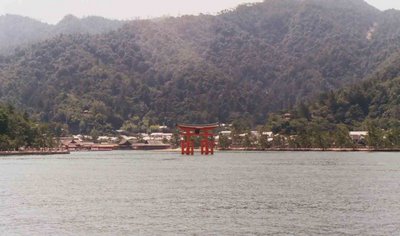Torii, O-Torii
Mentioned in another post, the torii is a simple gate leading to a shrine (vs the more substantial gates). Simple because it's just 2 upright poles with 2 crossbars across the top. But of course, you can still do a lot with a simple design.
You can make it really big, like this 12 meter high O-torii at Meiji-Jingu in Tokyo. This is made of cypress, and is 1500 years old. I don't know why some are O-torii, and some just torii, but I suspect it has to do with size and significance.
 This should give you an idea of the size of this
This should give you an idea of the size of this 
one. (Baker)
Paint it a brilliant vermillion, surrounded by lush foliage, as here at Ryoan-ji in Kyoto.
 Or leave it to weather, as here in Kasuga Taisha in Nara. Behind it are some of the 3,000 stone and bronze lanterns on the grounds.
Or leave it to weather, as here in Kasuga Taisha in Nara. Behind it are some of the 3,000 stone and bronze lanterns on the grounds.
Another option is to stack 'em up, making a tunnel effect, as in the Zeniarai-Benten shrine in Kamakura.

This one is out of stone... I think. This one was at

Ginkaku-ji in Kyoto. (Baker)
Or, you could put it in the ocean, which is where the most famous O-torii is. This O-torii is for the Itsukushima-jinga on Miyajima island. It is 16 meters tall, and was erected in 1875 (16 previous ones). We timed our arrival so that we could be sure to see the O-torii with plenty of ocean around it. In this first picture you can see the buildings of the shrine off in the distance. You can see the tide marker in the second picture.


 Hey, rare proof that Alan and I were in Japan together!
Hey, rare proof that Alan and I were in Japan together! Later on, the tide goes out, and you can walk out to the O-torii, but it definitely doesn't look as impressive!
Later on, the tide goes out, and you can walk out to the O-torii, but it definitely doesn't look as impressive! And, arguably the largest torii in Japan is at Heian-jingu in Kyoto, built out of concrete and painted a bright vermillion. This one is 24 meters tall. Hard to miss! (Baker)
And, arguably the largest torii in Japan is at Heian-jingu in Kyoto, built out of concrete and painted a bright vermillion. This one is 24 meters tall. Hard to miss! (Baker)

0 Comments:
Post a Comment
<< Home